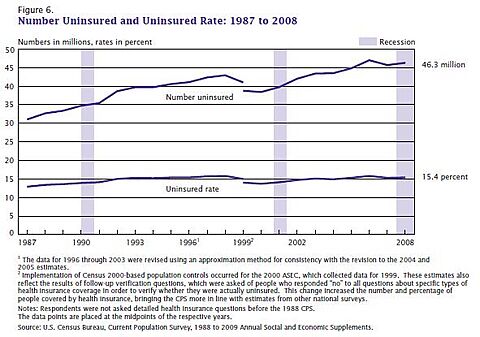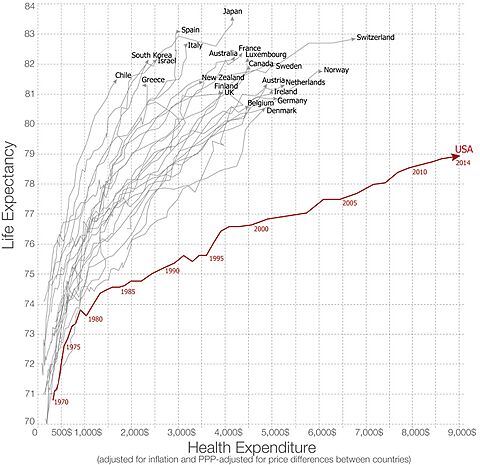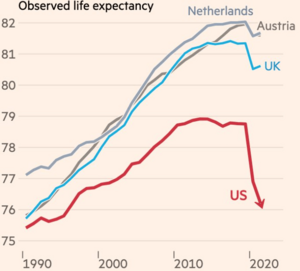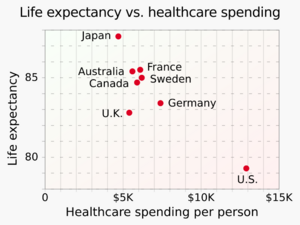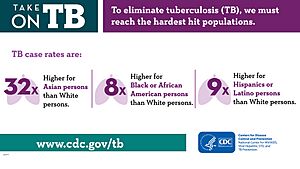Healthcare in the United States facts for kids
Healthcare in the United States is mostly provided by private hospitals and clinics. People pay for it using a mix of government programs, private insurance, and money directly from their pockets. The U.S. is the only developed country without a system where everyone automatically gets healthcare. Because of this, many people in the U.S. do not have health insurance.
The U.S. spends more money on healthcare than any other country. This is true both for the total amount spent and for the percentage of the country's total income (GDP). However, spending a lot of money does not always mean people are healthier overall compared to other developed nations. How much care people get depends a lot on their group. For example, older people and those with lower incomes often get more complete care through government programs like Medicaid and Medicare.
The U.S. healthcare system has been a big topic of discussion and change. People often talk about healthcare costs, who has insurance, and the quality of care. Laws like the Affordable Care Act (ACA) of 2010 tried to fix some of these problems. Still, challenges remain. The number of people without insurance has changed over time. Also, access to care can be different based on things like income, race, and where people live. Most people get health insurance through their jobs.
The system is complicated and expensive. This leads to ongoing talks about its future. Even so, the United States is a world leader in new medical discoveries. It creates many new medicines and medical devices. During the COVID-19 pandemic, the U.S. government quickly developed vaccines. However, government spending on healthcare is growing very fast.
In the early 1900s, new medical technologies and a focus on public health changed healthcare. The American Medical Association (AMA) helped make medical education the same everywhere. Also, companies started offering health insurance to their employees. This was the start of today's health insurance system. More groups, like state governments and businesses, began to get involved. They wanted to make sure that only trained people provided medical services. After World War II, healthcare grew a lot. The Hill–Burton Act in 1946 gave federal money to build hospitals. Then, Medicare and Medicaid were created in 1965. Medicare helps older people, and Medicaid helps people with low incomes get healthcare.
Contents
- History of Healthcare in the U.S.
- Healthcare Facts and Figures
- Healthcare Providers
- How Much is Spent on Healthcare?
- Rules and Oversight
- How Well Does the System Work?
- System Efficiency and Fairness
- Healthcare Reform Discussion
- Health Insurance for Immigrants
- More to Explore
- Images for kids
History of Healthcare in the U.S.

The story of healthcare in the United States goes back to the Colonial Era. Back then, families and neighbors usually helped sick people. In the 1800s, medicine started to become a real profession. Doctors began to get special training and licenses. This led to the creation of medical schools and groups for doctors. Even with these changes, healthcare services were not the same everywhere. People in cities often had better access than those in rural areas. Hospitals also started to become common places for sick people to get care.

Later in the 1900s, healthcare continued to change. During World War II, companies could not offer higher salaries. So, they started offering health insurance as a job benefit. This is how employer-sponsored health insurance became a common practice today. The Health Maintenance Organization Act of 1973 encouraged new ways to manage care. New medical technologies also changed how doctors treated illnesses. In the 2000s, the Affordable Care Act (ACA) was passed in 2010. This law helped millions of uninsured Americans get health coverage. It also aimed to improve care quality and lower costs.
Healthcare Facts and Figures
Hospital Stays

In 2016, there were about 35.7 million hospital stays in the U.S. This was fewer than in 2011. For every 1,000 people, about 104 people had a hospital stay. Each stay cost around $11,700 on average. In 2017, about 7.6% of people stayed overnight in a hospital. These stays lasted about 4.6 days.
A study looked at how much healthcare costs a person over their whole life. It found that women's healthcare costs were higher than men's. This is partly because women tend to live longer. But even when adjusting for age, women's lifetime costs were still about 20% higher.
Health Insurance and Getting Care
Unlike most developed countries, the U.S. healthcare system does not cover everyone. In 1977, the U.S. was the only industrialized country without some form of national health insurance. Most people in the U.S. get coverage through private insurance and government programs. As of 2017, about 150 million people got health insurance through their job. Other large groups were covered by Medicaid (70 million), Medicare (50 million), and plans from the ACA marketplaces (17 million).
Government programs like Medicare, Medicaid, and the Children's Health Insurance Program paid for about 64% of health spending in 2013. People under 65 usually get insurance through their job or buy it themselves. Government workers get health insurance from the government as their employer. Many health plans now use "managed care." This means they try to improve quality and control costs.

Experts track how easy it is to get healthcare and how affordable it is. They look at things like:
- How many people have insurance.
- If people have a regular doctor.
- How often people visit the dentist.
- How many hospital stays could have been prevented.
- If people have trouble seeing a specialist.
- If people delay care because of the cost.
In 2004, a report noted that almost all other developed countries had health coverage for nearly everyone by 1990. Another study in 2009 found that nearly 45,000 deaths each year in the U.S. were linked to not having health insurance. Uninsured working Americans had a 40% higher chance of dying compared to those with private insurance.
The number of uninsured adults in the U.S. was highest at 18.0% in 2013, before the ACA started. It then dropped to 10.9% in 2016. By 2018, it went up to 13.7%. This meant about seven million more adults were without health insurance.
The U.S. Census Bureau reported that 28.5 million people (8.8%) did not have health insurance in 2017. This was down from 49.9 million (16.3%) in 2010. After the ACA started in 2014, more low-income Americans started getting healthcare.
Studies show that expanding Medicaid under the ACA helped people get regular care and afford it. A 2016 study found that Medicaid expansion increased people's ability to afford care by about 60%. Also, an analysis suggested that Medicaid expansion saved lives. It cost about $327,000 to $867,000 per life saved. This is much less than other public policies, which cost an average of $7.6 million per life.
A 2009 study found that medical debt caused almost half of all personal bankruptcies. In 2007, 62.1% of people filing for bankruptcy said high medical costs were a reason. Since then, health costs and the number of uninsured people have grown. A 2013 study found that about 25% of older adults declare bankruptcy because of medical bills.
People without insurance often still get treated, but the cost is covered by taxes and other fees. This means the cost is shifted to others. If people avoid medical care because it costs too much, it can lead to bigger health problems later. This might be why the U.S. has the highest healthcare spending but also has high patient costs.
Some insured people are "underinsured." This means their insurance does not cover enough, and they cannot afford proper medical care. A 2003 study estimated that 16 million U.S. adults were underinsured. This mostly affected people with lower incomes. Not having insurance or having high costs makes it harder to get healthcare. Before the ACA in 2014, 39% of low-income Americans said they avoided seeing a doctor for a medical issue. In Canada, only 7% of low-income people did this, and in the UK, only 1% did.
U.S. Health Compared to Other Countries
In 2010, the average life expectancy in the U.S. was 78.6 years. This ranked 42nd out of 224 nations. By 2021, U.S. life expectancy dropped to 76.4 years. This was the shortest it had been in about two decades.
Main Causes of Death in the U.S.
Since the 1990s, the top three causes of death for all ages in the U.S. have been:
- Heart diseases (1st)
- Cancers (2nd)
- Brain disorders (3rd)
In 2015, heart disease caused 633,842 deaths. Cancer caused 595,930 deaths. Chronic lower respiratory disease caused 155,041 deaths. Many early deaths are also caused by things like murder, traffic accidents, and other accidents. For men under 50, over half of deaths are due to these reasons. For women under 50, 53% of deaths are due to disease, while 38% are due to accidents.
The Centers for Disease Control and Prevention (CDC) reported that U.S. life expectancy fell to 77.0 years in 2020. This was a drop of 1.8 years from 2019. It fell again in 2021 to 76.4 years, mainly because of COVID-19. By 2023, U.S. life expectancy increased slightly. However, it is still lower than in countries like Canada, China, and Germany.
Healthcare Providers
Healthcare providers in the U.S. include medical staff, hospitals, and companies that make medical products.
Hospitals and Clinics
Most healthcare facilities in the U.S. are privately owned. However, federal, state, county, and city governments also own some. As of 2018, there were 5,534 registered hospitals in the U.S. About 4,840 of these were community hospitals. These are general or specialty hospitals that are not run by the federal government. Most hospitals (about 70%) are non-profit. There are also privately owned for-profit hospitals and government hospitals in some places. The Hill–Burton Act of 1946 gave federal money to hospitals if they agreed to treat poor patients.
Some healthcare systems are "integrated." This means the doctors and the insurance company work together. They share the risks to provide good value care. In some areas, there are not many hospitals. This is because the local population is not big enough to support many hospitals.
About two-thirds of doctors work in small offices with fewer than seven doctors. Most of these are owned by the doctors themselves. Sometimes, these small groups join together to have more power when negotiating.
There is no single government-owned medical system for everyone in the U.S. However, local governments do own some medical facilities for the public. The U.S. Department of Defense runs hospitals for active military personnel. The federal Veterans Health Administration runs VA hospitals only for veterans. The Indian Health Service (IHS) runs facilities for Native Americans from recognized tribes.
Hospitals offer some outpatient care in their emergency rooms and special clinics. But their main job is to provide care for patients who stay overnight. Emergency departments and urgent care centers help with sudden problems. Surgicenters are special clinics for surgeries. Hospice services help people who are terminally ill. These are often supported by charities and the government. Services like prenatal care and family planning are also government-funded. Sometimes, doctors can even provide care remotely using telemedicine.
Besides government and private facilities, there are also 355 registered free clinics in the U.S. These clinics offer limited medical services. They are part of the "social safety net" for people without health insurance. Their services can range from treating sudden illnesses to long-term care like dentistry. Federally funded community health centers also help people get care.
Other healthcare facilities include long-term housing for older adults. As of 2019, there were 15,600 nursing homes in the U.S. Most of these (69.3%) were for-profit. In 2022, 19 hospitals either went bankrupt, closed, or announced plans to close.
Doctors (M.D. and D.O.)

Doctors in the U.S. are trained through the U.S. medical education system. Some are also international medical graduates who have passed the steps to get a medical license. This includes passing the three steps of the US Medical Licensing Examination (USMLE). These tests make sure doctors understand science, can apply medical skills, and can practice medicine on their own.
Most doctors in the U.S. have a Doctor of Medicine (M.D.) degree. Those with Doctor of Osteopathic Medicine (D.O.) degrees get similar training. They also go through the same tests as MDs and can use the title "physician."
Medical Products, Research, and New Discoveries
Private companies make and sell medicines and medical devices in the U.S. Research and development for these products get money from both public and private sources. In 2003, about $95 billion was spent on medical research. $40 billion came from public sources, and $55 billion came from private sources. These investments have made the U.S. a leader in medical innovation. It leads in new drugs and devices. In 2016, pharmaceutical companies in the U.S. spent about $59 billion on research.

The high cost of patented drugs in the U.S. has encouraged more research and development. However, the ACA might make drug companies sell medicines for less. This could lead to cuts in research budgets. In 2022, the U.S. had 10,265 drugs being developed. This was more than twice as many as China and the European Union.
Healthcare Jobs in the U.S.
The U.S. population is getting older. This means the healthcare system will need to provide more care. Older people are expected to increase medical expenses by 5% or more in North America. This is because "baby boomers" are reaching retirement age. Healthcare spending has increased since the late 1990s. It is growing faster than prices in general. People over 45 years old spend 8.3 times more on health services than those under 45.
Alternative Medicine
Other types of medical treatment are becoming more common. These are called Complementary and Alternative Medicine (CAM). CAM therapies are usually not taught in regular medical schools or found in hospitals. They include things like herbs, massages, energy healing, and homeopathy. More recently, cryotherapy and cupping have become popular.
People often seek CAM treatments to improve their well-being. They also want more control over their health. They might be looking for better ways to relieve symptoms from long-term illnesses. CAM aims to treat not just physical sickness but also its causes related to nutrition, social life, emotions, and spirituality. A 2008 survey found that 37% of hospitals in the U.S. offered at least one CAM treatment. The main reason was that patients asked for it. CAM treatments cost about $33.9 on average. Two-thirds of this was paid directly by patients. Spending on CAM grew from 2002 to 2008. Now, about 40% of adults in the U.S. use CAM.
How Much is Spent on Healthcare?
The U.S. spends a higher percentage of its GDP on healthcare than similar countries. This is because of higher prices for services, higher costs to manage the system, or more use of services. Healthcare costs are rising much faster than general prices. This has been a big reason for healthcare reform in the U.S. As of 2016, the U.S. spent $3.3 trillion on healthcare. This was 17.9% of its GDP, or $10,438 per person. For comparison, the United Kingdom spent $3,749 per person.
In 2018, an analysis found that high prices and management costs were the main reasons for high healthcare spending. This included prices for workers, medicines, and tests. High-cost procedures in the U.S. include angioplasties, C-sections, knee replacements, and CT and MRI scans. These scans are also used more often in the U.S.
Total U.S. hospital costs were $387.3 billion in 2011. This was a 63% increase since 1997, after adjusting for inflation. The cost per hospital stay increased by 47% since 1997, averaging $10,000 in 2011. As of 2008, government spending covered between 45% and 56% of U.S. healthcare costs.
According to the WHO, total healthcare spending in the U.S. was 18% of its GDP in 2011. This was the highest in the world. The Health and Human Services Department expects this to reach 19% of GDP by 2017. Of every dollar spent on healthcare in the U.S.:
- 31% goes to hospital care.
- 21% goes to doctor and clinic services.
- 10% goes to prescription drugs.
- 4% goes to dental care.
- 6% goes to nursing homes.
- 3% goes to home healthcare.
- 3% goes to other retail products.
- 3% goes to government public health activities.
- 7% goes to administrative costs.
- 7% goes to investment.
- 6% goes to other professional services (like physical therapists).
In 2017, a study estimated that nearly half of hospital care came from emergency department visits. As of 2017, data showed that care in the last year of life accounted for about 8.5% of costs.
Some people argue that the healthcare system is not working well. They say that because insurance pays most of the cost, patients do not think much about the financial choices. Also, there is often no clear price information for medical services. This can make it harder for people to make good decisions. Insurance companies negotiate prices with medical providers. Sometimes they use government prices, like Medicaid rates, as a starting point.
A study in Massachusetts in 2010 found that prices for the same services could vary a lot between providers and insurers. This was not based on the quality of care, but on how much power the providers had in the market. The study also found that price increases, not more use of services, explained most of the spending increases.
Economists suggest that the rise in healthcare costs in the U.S. is partly due to the "Baumol effect." This means that because healthcare needs a lot of human labor, and productivity in services grows slower than in making goods, the cost of services will rise compared to goods.
Rules and Oversight
Healthcare in the U.S. has many rules from both the federal and state levels. These rules often developed without a clear plan. States are mainly in charge of regulating healthcare. Important rules include:
- States licensing healthcare providers.
- The Food and Drug Administration (FDA) testing and approving medicines and medical devices.
- Rules for laboratory testing.
These rules protect people from ineffective or fake healthcare. States also regulate health insurance. They often require insurance companies to cover certain procedures.
In 2010, the ACA was signed into law. It added many new rules. One big rule was the health insurance mandate. This required most citizens to buy health insurance. The federal government also influences healthcare through its payments to providers under Medicare and Medicaid. These payments are sometimes used as a guide for prices between medical providers and insurance companies.
The U.S. Department of Health and Human Services (HHS) oversees many federal agencies involved in healthcare. These include:
- The FDA, which makes sure food is safe and drugs work.
- The CDC, which works to prevent disease and early death.
- The Agency for Healthcare Research and Quality, which aims to improve healthcare quality and safety.
- The National Institutes of Health, which does important medical research.
State governments have their own health departments. Local governments (counties and cities) often have health departments that work with the state. Healthcare providers also help with oversight. Many healthcare groups volunteer to be inspected and certified by the Joint Commission. Doctors also take tough tests to get board certification, which shows their high level of skill.
Final expense insurance is important in healthcare. This type of insurance helps cover costs like medical bills and funeral expenses at the end of life. It gives financial peace of mind to families during a difficult time.
The federal Centers for Medicare and Medicaid Services (CMS) has an online database. It shows how well nursing homes perform.
A 2004 study suggested that healthcare rules provide benefits but also cost a lot of money. It found that the majority of the cost difference came from medical malpractice, FDA rules, and facility rules.
"Certificates of Need" for Hospitals
In 1978, the federal government required states to have "Certificate of Need" (CON) programs for heart care. This meant hospitals needed permission before starting new heart programs. The goal was to lower costs by avoiding duplicate investments. However, these certificates could also increase costs by reducing competition. Many states removed CON programs after 1986. But some states still have them. Studies have not found a clear effect on costs when these programs are stopped.
Licensing Doctors
The American Medical Association (AMA) has worked to limit how many doctors are trained each year. This has led to a shortage of doctors. Another problem is that doctors are often paid for procedures, not for how well patients get better.
The AMA has also pushed for rules that require doctors to do tasks that could be done by other, less expensive healthcare workers. For example, in 1995, 36 states banned or limited midwifery. This was despite it being as safe as care from doctors. Economists say that these rules reduce the amount and quality of healthcare. They do not add to quality. Also, psychologists, nurses, and pharmacists are often not allowed to prescribe medicines.
Thirty-six states require healthcare workers to have criminal background checks.
Emergency Medical Treatment and Active Labor Act (EMTALA)
EMTALA is a federal law from 1986. It requires hospital emergency departments to treat all emergency conditions. This must happen no matter if the patient can pay. This law is important for people without insurance. However, the law did not set up a direct way to pay for this care. Government programs have never fully paid hospitals for the cost of care required by EMTALA. More than half of all emergency care in the U.S. is now unpaid. Some say EMTALA has put financial pressure on hospitals. This has led to hospitals closing and emergency rooms becoming overcrowded. Between 1993 and 2003, emergency room visits in the U.S. grew by 26%. But the number of emergency departments dropped by 425.
Patients with mental illness are a special challenge. EMTALA requires emergency rooms to check them for medical emergencies. Once they are medically stable, mental health agencies are called. They decide if the patient is a danger to themselves or others. If so, the patient is admitted to a mental health facility for more evaluation. Patients can usually be held for up to 72 hours. After that, a court order is needed.
Quality Control
Healthcare quality control means activities and programs that aim to make care better. This includes checking care quality, finding problems, creating ways to fix them, and watching to make sure the fixes work. Some private companies also share quality information.
One new idea to improve healthcare quality is publicly sharing how well hospitals and doctors perform. However, there is no clear proof that this changes how people choose care or makes care better.
How Well Does the System Work?
How We Measure Effectiveness
The U.S. healthcare system provides medical care that varies in quality. In a good healthcare system, people would get reliable care that meets their needs. This care would be based on the best scientific knowledge. To check how well the system works, researchers track measures over time. The HHS has a public dashboard called the Health System Measurement Project. It tracks:
- Access to care.
- Quality of care.
- Cost of care.
- Overall population health.
- How the health system changes (like workforce and new ideas).
Waiting Times
Waiting times for non-urgent care in the U.S. are usually short. However, some patients do wait longer than they expect. A 2010 survey found that most Americans waited less than four weeks for a specialist appointment. They also waited less than one month for elective surgery. But about 30% of patients waited longer than one month for elective surgery. About 20% waited longer than four weeks for a specialist. These percentages were smaller than in some other countries like France and Canada.
Population Health: Quality and Prevention
The health of the population also shows how effective the healthcare system is. If people live longer, healthier lives, it means the system is working well.
- The HHS uses a "composite health measure." This estimates not only how long people live but also how much of that life is spent in good health. Between 1997 and 2010, the number of expected high-quality life years for newborns increased from 61.1 to 63.2 years.
- The U.S. healthcare system does not do enough to promote wellness. People do not use preventive measures enough. Rates of preventable illnesses and long-term diseases are high. Obesity, heart disease, and type 2 diabetes are big concerns. The number of people with obesity more than doubled among adults from 1980 to 2008. It more than tripled among children and teens.
- Health benefits are not shared equally among everyone. In the U.S., there are big differences in healthcare and health outcomes. Minority groups are more likely to get serious illnesses. They are also less likely to get quality healthcare, including preventive services. Efforts are being made to close these gaps.
Innovation: Workforce, IT, and Research
The U.S. tracks how much it invests in healthcare. This includes having a skilled healthcare workforce, using health information technology (IT), and creating new research. This is important when looking at healthcare costs. People who support new technologies say that innovation shows an effective healthcare system.
Compared to Other Countries
A 2014 study found that the U.S. healthcare system is the most expensive in the world. But it ranked last in most areas of performance compared to other developed countries. The study found that the U.S. did not have better health outcomes. It was last or near last in access, efficiency, and fairness.
As of 2017, the U.S. ranked 43rd in the world for life expectancy (80.00 years). In 2007, the U.S. ranked 42nd best in the world for infant mortality rate. Americans also get cancer screenings more often than people in other developed countries. They also get MRI and CT scans more than any other developed nation.
A 2008 study found that 101,000 people die each year in the U.S. who would not if the healthcare system were as effective as in France, Japan, or Australia. A 2020 study said that the U.S. "spends huge sums of money for some of the worst health outcomes in the Western world."
The OECD found that the U.S. ranked poorly in "years of potential life lost." This measures years of life lost before age 70 that could have been saved by healthcare. The U.S. ranked third last for women's healthcare and fifth last for men's healthcare among OECD nations.
Recent studies show growing differences in life expectancy based on income and location. The gap is growing between rich and poor people. However, it is narrowing between men and women and by race.
The debate about U.S. healthcare involves questions of access, efficiency, and quality. The WHO in 2000 ranked the U.S. healthcare system first in how well it responds to people's needs. But it ranked 37th in overall performance and 72nd in overall health level.
A report in 2008 looked at children's health in the U.S. from 1994 to 2006. It found mixed results. Death rates for children aged 1 to 4 dropped by a third. The percentage of children with high lead levels in their blood dropped by 84%. But both obesity and the percentage of low-birth weight babies increased.
System Efficiency and Fairness
Differences in how healthcare is delivered can lead to different outcomes. For example, a project found that big differences in how medical resources are used in the U.S. led to big differences in health outcomes. Doctors' willingness to work in an area depends on the income of the area and what it offers. This problem is made worse by a general shortage of doctors in the U.S., especially primary care doctors.
Lean manufacturing techniques can help find and reduce waste in healthcare costs. Other tools like FMEA and Fish Bone Diagrams have been used to make healthcare delivery more efficient.
Since 2004, the Commonwealth Fund has compared healthcare systems in wealthy countries. It looks at access to care, the care process, administrative efficiency, fairness, and health outcomes. The U.S. has been rated as the worst healthcare system overall among 11 wealthy countries in every report. This is true even though it spends the highest percentage of its GDP on healthcare. In 2021, Norway, the Netherlands, and Australia were the top-performing countries. The U.S. spent 16.8% of its GDP on healthcare in 2019. The next highest country, Switzerland, spent 11.3%.
Efficiency
Preventable Deaths
In 2010, heart disease, lung cancer, stroke, and traffic accidents caused the most years of life lost in the U.S. Back pain, depression, and neck pain caused the most years lost to disability. The biggest risk factors were poor diet, smoking, obesity, high blood pressure, and lack of physical activity.
Between 1990 and 2010, the U.S. dropped in rankings for age-standardized death rates and life expectancy. It dropped from 20th to 27th in life expectancy at birth.
A 2009 study found that not having health coverage was linked to nearly 45,000 extra preventable deaths each year. As the number of uninsured people grew, this number also grew to about 48,000 per year.
Value for Money
A study in 2000 found that the U.S. spends much more on healthcare than any other country. But the use of healthcare services in the U.S. is lower than average. The study concluded that prices for healthcare services are much higher in the U.S. than elsewhere. Other wealthy countries pay less than half of what the U.S. does for healthcare. Yet, they have gained about six more years of life expectancy than the U.S. since 1970.
Delays in Seeking Care and More Emergency Care
Americans without insurance are less likely to have regular healthcare. They are also less likely to use preventive services. They often delay seeking care. This leads to more medical crises, which cost more than ongoing treatment. A 2007 study found that uninsured people were less likely to get medical care after an injury or a new long-term condition. Uninsured patients are also twice as likely to visit hospital emergency rooms. This puts a burden on a system meant for true emergencies.
In 2008, researchers found that people without private insurance were more likely to be diagnosed with late-stage cancer.
Differences in Doctor Practices
The treatment a patient gets can vary a lot depending on which healthcare providers they use. Some cost-effective treatments are not used enough. But other services are used too much. Unnecessary treatments increase costs and can cause patients stress. The use of prescription drugs also varies a lot by region.
When people have insurance, they might use more healthcare because they do not pay the full cost directly. This is called "moral hazard." The healthcare system tries to fix this with things like copays and deductibles. If patients pay more, they might only use healthcare when they really need it. Studies show that patients with higher costs to pay used less healthcare. For poorer and sicker people, this could lead to negative effects. They might skip necessary preventive care to save money. This can lead to late diagnoses and more expensive procedures later.
One study found big differences in Medicare spending for patients in their last two years of life. These spending levels were linked to how many hospitals were available in each area. Higher spending did not mean patients lived longer.
Care Coordination
Primary care doctors are often the first point of contact for patients. But in the U.S. healthcare system, many patients and doctors have problems with care coordination. For example, a survey of California doctors found that:
- Four out of ten doctors said their patients had problems coordinating their care in the last year.
- More than 60% of doctors said their patients "sometimes" or "often" waited a long time for tests.
- About 20% of doctors said their patients had to repeat tests because results could not be found.
The relationship between doctors and patients is changing. Some studies suggest that about one in four patients think their doctors have exposed them to unnecessary risks. This might be due to how doctors are trained or different views on medicine. Doctors might focus on diagnosis and treatment. Patients might be more interested in wellness and being heard.
Many primary care doctors no longer see their patients in the hospital. Instead, "hospitalists" are used. Insurance companies sometimes require this to save money. Some primary care doctors do not like this.
Administrative Costs
As of 2017, there were 907 health insurance companies in the U.S. The top 10 companies make up about 53% of the money earned. The large number of insurers adds to administrative costs. These costs are higher than in countries with single-payer systems, like Canada.
Insurance groups estimate that administrative costs have been about 12% of premiums for the last 40 years. These costs have shifted from processing claims to managing medical care and negotiating prices.
A 2003 study found that health insurer administrative costs were about 11% to 12% of premiums. The biggest increases in administrative costs were in customer service and information technology. The McKinsey Global Institute estimated that extra spending on "health administration and insurance" was as much as 21% of the total extra spending in 2003.
A 2008 report found that administrative costs for private insurance were about 12% of premiums. These costs vary depending on the size of the employer. Coverage for large employers has the lowest administrative costs. The percentage of premium for administration is highest for individual plans.
One study looked at billing and insurance-related costs for insurers, doctors, and hospitals in California. It found that these costs were 20–22% of privately insured spending in acute care settings.
Long-Term Care Facilities
A 2014 report found that the higher the skill of a registered nurse (RN), the lower the financial burden on long-term care facilities. As the elderly population grows, more patients in these facilities need more care. This increases financial costs. Research from 2010 showed that annual out-of-pocket costs jumped 7.5%. Medicare costs grew 6.7% annually. While Medicare pays for some elderly care, 40% of patients in these facilities pay out of their own pockets.
Third-Party Payment Problem and Consumer-Driven Insurance
Most Americans pay for medical services through insurance. This can change how consumers make choices. They only pay a small part of the total cost directly. Also, there is often no clear price information for medical services. This can also affect choices. Insurance companies negotiate with medical providers. Sometimes they use government prices as a guide.
This has led to calls for changes to the insurance system. The idea is to create a "consumer-driven healthcare" system. In this system, consumers would pay more directly. In 2003, a law was passed that encourages people to have a high-deductible health plan and a health savings account. In 2019, Colorado suggested a public healthcare option through private insurers. This option was expected to be 9% to 18% cheaper by 2022.
Fairness
Mental Health
In 2020, 52.9 million adults in the U.S. were affected by mental illness. This is nearly one in five adults. In 2006, mental disorders were among the top five most expensive medical conditions. They cost $57.5 billion. Not having mental health coverage has big effects on the U.S. economy and society. A report found that mental illnesses are the second leading cause of disability in the nation. They affect 20% of all Americans.
It is estimated that less than half of people with mental illnesses get treatment. This is due to things like stigma and not enough access to care. There is also a shortage of mental health professionals. Some groups try to expand access to mental health services. They offer services on a sliding scale or at reduced fees.
The Paul Wellstone Mental Health and Addiction Equity Act of 2008 requires health plans to provide mental health and addiction benefits. These benefits must be similar to those for medical and surgical procedures. The law aims for fair financial coverage for mental health benefits. It also requires fairness in treatment limits and extends these rules to addiction services.
Oral Health
In the U.S., dental care is often not seen as part of general healthcare. People visit a dentist more often than a general doctor. So, dental care developed separately. Today, oral health is considered different from primary health. Dental insurance is separate from health insurance.
Differences in access to oral healthcare mean many people have poor oral health. This includes people without insurance, low-income individuals, minorities, immigrants, and rural populations. While changes have been made for children, the differences in adult oral health have stayed the same or gotten worse.
For example, in New York state, Medicaid includes dental coverage. But seven out of ten older adults have gum disease. One in four older adults has no teeth. The state's rule prevents Medicaid from covering new dentures within eight years of the first set. It also bans coverage for dental implants. Older adults are also more likely to have other medical conditions that worsen their oral health.
Demographic Differences
Health differences are well known in the United States among ethnic minorities. These include African Americans, Native Americans, and Hispanics. Compared to white people, these groups have:
- More long-term diseases.
- Higher death rates.
- Worse health outcomes.
- Lower rates of diagnosis and treatment.
For example, the cancer rate among African Americans is 25% higher than among white people. Adult African Americans and Hispanics are about twice as likely to get diabetes. They also have higher obesity rates. Minorities also have higher rates of heart disease and HIV/AIDS. In the U.S., life expectancy varies by race: Asian American (87.1 years), Latino (83.3 years), White (78.9 years), Native American (76.9 years), and African American (75.4 years).
Government spending on healthcare is higher for older people. Average spending for seniors was more than five times that for children. Spending for non-Hispanic blacks was slightly higher than for white people. Spending for Hispanics was much lower than the average. Seniors make up 13% of the population but use one-third of all prescription drugs. The average senior fills 38 prescriptions each year.
There is a lot of research on unfairness in healthcare. In some cases, these differences are caused by income gaps. This leads to a lack of health insurance and other barriers, like not having medical equipment. Uninsured Americans are less likely to get preventive services. For example, minorities are not regularly screened for colon cancer. The death rate for colon cancer has increased among African Americans and Hispanic people.
In other cases, unfairness in healthcare shows a bias in how medical procedures are prescribed for different racial groups. Studies have consistently found that Black Americans received less healthcare than white Americans. This was especially true for expensive new technology. One recent study found that when minority and white patients use the same hospital, they get the same standard of care. The lack of fair access to different resources is linked to public health. Public health works to add other services to the traditional medical system.
Medical devices are expensive. This is because designing and approving them is a long and costly process. The costs include research, design, development, meeting FDA rules, manufacturing, marketing, and distribution. These costs, along with unfairness in communities of color, make medical equipment hard to get. Most studies agree that increasing access to medical devices is very important for meeting healthcare needs.
The growth of artificial intelligence (AI) in healthcare brings up issues of fairness and bias. This is related to how health apps are developed and used. AI expansion is now a big global interest for public and private investment. One local government in London launched an AI system to match people with providers and create care plans. In the U.S., the FDA approved an AI medical imaging platform in 2017. A recent review found 18 fairness issues with AI in healthcare. It also found 15 strategies to address them. The goal is to make sure AI apps fairly meet the needs of all people.
Healthcare Reform Discussion
In 2008, before the big healthcare reform in 2010, Americans had different views on the U.S. health system. 45% thought the U.S. system was best. 39% thought other countries' systems were better.
Much of the discussion about healthcare reform focused on single-payer healthcare. This system would have the government pay for everyone's healthcare. Supporters pointed to the hidden costs of treating uninsured people. Those who support free markets talked about freedom of choice in buying health insurance. They also warned about unintended problems from government involvement.
A 2020 study estimated that a single-payer system could save 68,000 lives and $450 billion in healthcare spending each year. Another 2022 study estimated that a universal healthcare system could have saved over 338,000 lives during the COVID-19 pandemic.
In the end, a single-payer healthcare system, sometimes called "socialized medicine," was not adopted in the final ACA.
Patient Protection and Affordable Care Act (2010)
The ACA (Public Law 111–148) is a healthcare reform law. President Barack Obama signed it into law on March 23, 2010. The law has many health-related rules. Most of these started in 2014. Key parts include:
- Expanding Medicaid to cover more people.
- Helping people pay for insurance premiums.
- Setting limits on how much individuals or families have to pay out of their own pocket each year.
- Giving incentives for businesses to offer healthcare benefits.
- Stopping insurance companies from denying coverage or claims because of pre-existing conditions.
- Creating health insurance exchanges where people can buy plans.
- Stopping insurers from setting yearly spending limits.
- Supporting medical research.
The costs of these rules are covered by taxes, fees, and cost-saving measures. These include new Medicare taxes for high-income earners and fees on medical devices. There is also a tax penalty for citizens who do not get health insurance. The Congressional Budget Office estimated that the law would reduce the federal deficit. However, they later said more funds were needed. They also estimated that individual insurance plans would be more expensive with the ACA than without it.
The first sign-up period for the ACA began in October 2013. Before this, access to healthcare and insurance coverage was getting worse. After the first two sign-up periods, more people reported having coverage, better health, and better access to care. Insurance coverage for low-income adults was much higher in states that expanded Medicaid. However, there are still differences between those covered by Medicaid and those with private insurance. People with Medicaid often report fair or poor health.
On December 22, 2017, the Tax Cuts and Jobs Act of 2017 became law. This bill removed the individual mandate from the ACA. This mandate required people and companies to get healthcare. Economists believe removing this mandate will lead to higher premiums and fewer people signing up for insurance. In 2017, the new Republican healthcare bill, the American Health Care Act of 2017, passed the House of Representatives. This bill affected Americans differently than the ACA. Young people, higher-income individuals, and people in cities might benefit more from this plan.
In May 2023, an international newspaper said that the United States needs to make healthcare a basic human right for all its citizens.
Health Insurance for Immigrants
In 1998, 26.2 million foreign immigrants lived in the U.S. About 62.9% were not U.S. citizens. In 1997, 34.3% of non-U.S. citizens did not have health insurance. This was compared to 14.2% of native-born Americans. Among immigrants who became citizens, 18.5% were uninsured. For non-citizens, 43.6% were uninsured. In every age and income group, immigrants were less likely to have health insurance. With recent healthcare changes, many legal immigrants can now get affordable health insurance.
Undocumented immigrants in the U.S. cannot get government-funded health insurance. While the ACA helps immigrants get discounted insurance, it does not apply to those without U.S. citizenship. Undocumented immigrants can get medical help from community centers or "Safety Net Providers." They can also pay for medical assistance per service. But they can only buy health insurance from private companies.
More to Explore
- Biomedical research in the United States
- Canadian and American health care systems compared
- Health in the United States
- Health care systems (including comparisons)
- Health insurance cooperative
- Healthy People program
- Medical debt
- Medical education in the United States
- Military Health System
- Osteopathic medicine in the United States
- School health services
Images for kids



